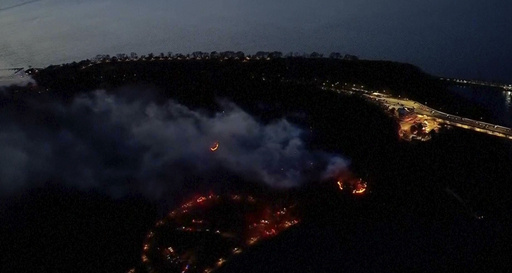
DENVER — The northeastern United States is experiencing an unusual fall, characterized by an alarming lack of rainfall and a spate of wildfires that have engulfed parks and forests near New York City. Data from the Applied Climate Information System reveals that cities and towns stretching from Portsmouth, New Hampshire, to areas south of Philadelphia have recorded their driest three months to date. Some local reservoirs are nearing historical lows, raising concerns about future water shortages. Experts emphasize the need for significant changes in water management to prevent critical water scarcity, which may become a growing issue as climate change exacerbates drought conditions.
According to Tim Eustance, the executive director of the North Jersey District Water Supply Commission, the current situation serves as a warning for potential future crises. He urges immediate action, suggesting that’s it’s time for residents to cease lawn watering altogether. Eustance is calling on New Jersey Governor Phil Murphy to declare a drought emergency to heighten public awareness of the urgency of the situation.
To navigate future water shortages, experts propose several strategies that could be essential for the Northeast. One noteworthy method involves enhancing groundwater replenishment. Groundwater reserves have substantially decreased in parts of Delaware, Maryland, New Jersey, and New York. In fact, groundwater accounts for approximately half of New Jersey’s drinking water supply. However, urban development and concrete surfaces impede rainwater from reaching underground sources. Eustance points out that the vast parking areas common in New Jersey can be redesigned to capture rainwater instead of contributing to runoff. Some areas of the country are already employing permeable materials that allow water to seep back into the ground, and Eustance believes it is up to local governments to mandate these practices.
An alternative method of aquifer replenishment involves injecting highly treated wastewater back into the ground—a technique that Los Angeles has successfully utilized for years, significantly increasing its available water supply. Virginia Beach has also adopted this practice, and legislative efforts are underway in Anne Arundel County, Maryland, to allow similar operations.
In certain western U.S. regions, financial incentives are provided to encourage water conservation practices. Residents receive payments for replacing lawns with native plants. However, such initiatives are relatively rare in the Northeast, as noted by Alan Roberson, CEO of the Association of State Drinking Water Administrators. The prevailing perception of abundance makes it challenging to engage the community in conservation efforts. Upgrading water meters can offer residents insights into their consumption patterns, helping them identify potential savings, as indicated by Beth O’Connell, chief engineer for Anne Arundel County.
The idea of reusing water is gaining attention as well. This involves capturing water from various domestic sources such as sinks, washing machines, and toilets, treating it for non-potable uses, and redirecting it for tasks like toilet flushing or irrigation. Eustance criticizes the practice of using drinking water for lawns and toilets, stating it is an inefficiency that must be addressed. Zach Gallagher, the CEO of Natural Systems Utilities and a concerned parent, emphasizes the importance of sustainable water practices for the benefit of future generations. He highlights the dual advantages of water reuse, which can alleviate stress on aging sewer systems while also addressing water scarcity.
Gallagher’s company has plans to repurpose the old Domino Sugar Refinery on New York’s East River, enabling it to treat up to 400,000 gallons of wastewater daily. This treated water will be utilized in various capacities within new mixed-use buildings, including for toilets and landscaping, while some will be returned to the river.
The concept of non-potable water reuse is gradually gaining traction in the eastern U.S., but scaling these efforts at a regional level should be a primary focus, suggests O’Connell. Transitioning towards conservation may entail a financial investment and a profound cultural shift, according to Del Shannon, a dam engineer affiliated with the American Society of Civil Engineers. His global experience in water-related projects highlights the need for developed countries to adopt a more cautious approach akin to those in developing nations, who often prioritize securing reliable water for essential needs like agriculture and drinking.
As the conversation surrounding water management continues, it is clear that proactive, community-oriented strategies are essential for ensuring a sustainable future as climate dynamics shift.
